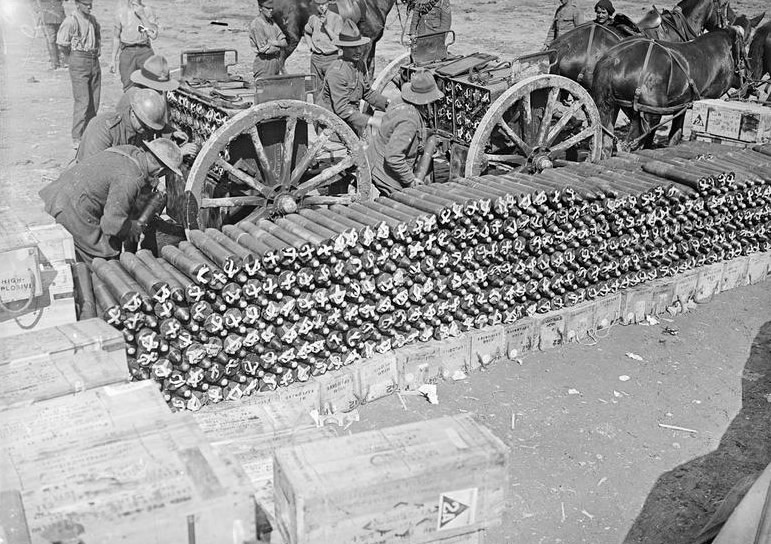
Gunners of the New Zealand Field Artillery loading ammunition onto limbers near Albert, September 1916.
New Zealand artillery on the Somme, 1916
At 6.20 a.m. on 15 September 1916, the boom of more than a thousand guns heralded the beginning of the new big push on the Somme. Amidst this awesome array of firepower were four brigades of the New Zealand divisional artillery. Deployed just three days before, these field gunners had the task of helping the infantry cross the battlefield and protecting them once they reached their objectives. Two brigades supported the New Zealand infantry, while the other two supported British infantry to their right.
In the preceding days, the New Zealand gunners had concentrated on preparing gun positions for the advance. Barbed-wire entanglements protecting enemy trenches had been targeted, while the longer-range howitzers blasted trenches, lines of communication, machine-gun nests, observation posts and other strongpoints. On 12 September, New Zealand gunners fired poison-gas shells for the first time.
Airmen in balloons or aircraft or forward observation officers – artillery officers stationed in the front line – called down concentrated fire from groups of batteries (later called ‘crashes’) on anything that moved around the German lines, while British heavy guns sought out enemy batteries. At 6 p.m. on the 14th a continuous heavy bombardment began.
At 6.20 next morning, field guns attached to the New Zealand Division opened fire along the 900 m of enemy trench line that was the infantry’s first target. Enemy troops who had been kept awake all night by the preliminary shelling – and were now terrified at the prospect of imminent attack – took cover from a rain of steel that lasted for minutes but felt like hours. Then the creeping barrage began, starting in no-man’s-land and lifting (advancing) by 45 m each minute until it reached the second trench line, which was pounded for some time. In large-scale attacks like this one, a combination of stationary and creeping barrages was repeated several times.
The Allied infantry advanced just behind the creeping barrage, sometimes having to wait for it to lift forward. ‘Friendly fire’ casualties were regarded as inevitable. Laying errors, defective shells, worn gun barrels – all could lead to shells falling short. Attacking troops advancing too quickly sometimes entered the curtain. These were considered acceptable risks, for if the men were not following the creeping barrage closely when it reached the enemy line, machine-gunners would inflict far more casualties than the occasional drop-short shell. As the troops approached the enemy line, the stationary barrage lifted to the line behind and the creeping barrage swept over the trench with the troops right behind, leaving the defenders no time to man their machine guns. Men with bayonets were soon in the trench among them.
On this morning, the attack plan worked well. The attacking infantry were shielded as they approached their initial objectives — Crest Trench and, 230 m beyond, Switch Trench — and the defenders were bayoneted, taken prisoner (not many) or shot as they fled. The artillery then shifted to the main objective, the Flers Trench system, while the leapfrogging riflemen carried on the advance without a creeping barrage. When uncut barbed wire held them up at one point, a tank quickly opened the way by crushing this and Flers Trench was seized. Next morning the gunners broke up a counter-attack before helping the infantry take their final objective, Grove Alley.
Following the 15 September attack, the artillery continued to play an active role in the battle. A deluge of shells usually broke up German counter-attacks before they got near the New Zealanders’ lines. Forward observers called this fire down from observation posts close to the line. On three further occasions before the New Zealand infantry withdrew, the gunners carried out fire-plans to support assaults.
The gunners remained in the line when the New Zealand Division was withdrawn on 5 October. For another three weeks, they toiled over their pieces, often under bombardment with little cover. It was a miserable time for the gunners, who were often soaked, cold and hungry.
There was relief, therefore, when they too were pulled out in the last week of October 1916. By this time, more than 500 of them had become casualties. In all, the New Zealand gunners had fired half a million shells at the Germans.

Community contributions